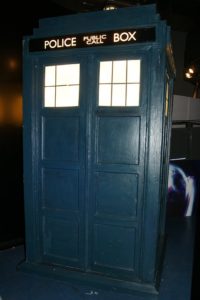Time Travel

Arguably, we are always travelling though time, as we move from the past into the future. But time travel usually refers to the possibility of changing the rate at which we travel into the future, or completely reversing it so that we travel into the past. Although a plot device in fiction since the 19th Century (see the section on Time in Literature), time travel has never been practically demonstrated or verified, and may still be impossible.
Time travel is not possible in Newtonian absolute time (we move deterministically and linearly forward into the future). Neither is it possible according to special relativity (we are constrained by our light cones). But general relativity does raises the prospect (at least theoretically) of travel through time, i.e. the possibility of movement backwards and/or forwards in time, independently of the normal flow of time we observe on Earth, in much the same way as we can move between different points in space.
Time travel is usually taken to mean that a person’s mind and body remain unchanged, with their memories intact, while their location in time is changed. If the traveller’s body and mind reverted its condition at the destination time, then no time travel would be perceptible.
Time Travel Scenarios
Although, in the main, differing fundamentally from the H.G. Wells concept of a physical machine with levers and dials, many different speculative time travel solutions and scenarios have been put forward over the years. However, the actual physical plausibility of these solutions in the real world remains uncertain.
At its simplest, as we have seen in the section on Relativistic Time, if one were to travel from the Earth at relativistic speeds and then return, then more time would have passed on Earth than for the traveller, so the traveller would, from his perspective, effectively have “travelled into the future”. This is not to say that the traveller suddenly jumped into the Earth’s future, in the way that time travel is often envisioned, but that, as judged by the Earth’s external time, the traveller has experienced less passage of time than his twin who remained on Earth. This is not real time travel, though, but more in the nature of “fast-forwarding” through time: it is a one-way journey forwards with no way back.
There does, however, appear to be some scientific basis within the Theory of Relativity for the possibility of real time travel in certain scenarios. Kurt Gödel showed, back in the early days of relativity, that there are some solutions to the field equations of general relativity that describe space-times so warped that they contain “closed time-like curves”, where an individual time-cone twists and closes in on itself, allowing a path from the present to the distant future or the past. Gödel’s solution was the first challenge in centuries to the dominant idea of linear time on which most of physics rests. Although a special case solution, based on an infinite, rotating universe (not the finite, non-rotating universe we actually find ourselves in), other time travel solution have been identified since then that do not require an infinite, rotating universe, but they remain contentious.
In the 1970s, controversial physicist Frank Tipler published his ideas for a “time machine”, using an infinitely long cylinder which spins along its longitudinal axis, which he claimed would allow time travel both forwards and backwards in time without violating the laws of physics, although Stephen Hawking later disproved Tipler’s ideas.
In 1994, Miguel Alcubierre proposed a hypothetical system whereby a spacecraft would contract space in front of it and expand space behind it, resulting in effective faster-than-light travel and therefore (potentially) time travel, but again the practicalities of constructing this kind of a “warp drive” remain prohibitive.

Other theoretical physicists like Kip Thorne and Paul Davies have shown how a wormhole in space-time could theoretically provide an instantaneous gateway to different time periods, in much the same way as general relativity allows the theoretical possibility of instantaneous spatial travel through wormholes. Wormholes are tubes or conduits or short-cuts through space-time, where space-time is so warped that it bends back on itself, another science fiction concept made potential reality by the Theory of Relativity. The drawback is that unimaginable amounts of energy would be required to bring about such a wormhole, although experiments looking into the possibility of creating mini-wormholes and mini-black holes are being carried out at the particle accelerator at CERN in Switzerland. It also seems likely that such a wormhole would collapse instantly into a black hole unless some method of holding it open were devised (possibly so-called “negative energy”, which is known to be theoretically possible, but which is not yet practically feasible). Stephen Hawking has suggested that radiation feedback, analogous to feedback in sound, would destroy the wormhole, which would therefore not last long enough to be used as a time machine. Actually controlling where (and when) a wormhole exits is another pitfall.
Another potential time travel possibility, although admittedly something of a long shot, relates to cosmic strings (or quantum strings), long shreds of energy left over after the Big Bang, thinner than an atom but incredibly dense, that weave through the entire universe. Richard Gott has suggested that if two such cosmic strings were to pass close to each other, or even close to a black hole, the resulting warpage of space-time could well be so severe as to create a closed-time-like curve. However, cosmic strings remain speculative and the chances of finding such a phenomenon are vanishingly small (and, even if it were possible, such a loop may well find itself trapped inside a rotating black hole).
Physicist Ron Mallet has been looking into the possibility of using lasers to control extreme levels of gravity, which could then potentially be used to control time. According to Mallet, circulating beams of laser-controlled light could create similar conditions to a rotating black hole, with its frame-dragging and potential time travel properties.
Others are looking to quantum mechanics for a solution to time travel. In quantum physics, proven concepts such as superposition and entanglement effectively mean that a particle can be in two (or more) places at once. One interpretation of this (see the section on Quantum Time) is the “many worlds” view in which all the different quantum states exist simultaneously in multiple parallel universes within an overall multiverse. If we could gain access to these alternative parallel universes, a form of time travel might then be possible.
At the sub-sub-microscopic level – at the level of so-called quantum foam, tiny bubbles of matter a billion-trillion-trillionths of a centimetre in length, perpetually popping into and out of existence – it is speculated that tiny tunnels or short-cuts through space-time are constantly forming, disappearing and reforming. Some scientists believe that it may be possible to capture such a quantum tunnel and enlarge it many trillions of times to the human scale. However, the idea is still at a very speculative stage,
It should be noted that, with all of these schemes and ideas, it does not look to be possible to travel any further back in time that the time at which the travel technology was devised.
Faster-Than-Light Particles
The equations of relativity imply that faster-than-light (superluminal) particles, if they existed, would theoretically travel backwards in time. Therefore, they could, again theoretically, be used to build a kind of “antitelephone” to send signals faster than light, and thus communicate backwards in time. Although the Theory of Relativity disallows particles from accelerating from sub-light speed to the speed of light (among other effects, time would slow right down and effectively stop for such a particle, and its mass would increase to infinity), it does not preclude the possibility of particles that ALWAYS travel faster than light. Therefore, the possibility does still exist in theory for faster-than-light travel in the case of a particle with such properties.
There is a rather strange theoretical particle in physics called the tachyon that routinely travels faster than light, with the corollary that such a particle would naturally travel backwards in time as we know it. So, in theory, one could never see such a particle approaching, only leaving, and the particle could even violate the normal order of cause and effect. For a tachyon, the speed of light is the lower speed limit, while the upper speed limit is infinity, and its speed increases as its energy decreases. Even stranger, the mass of a tachyon would technically be an imaginary number (i.e. the number squared is negative), whatever that might actually mean in practice.
It should be stressed that there is no experimental evidence to suggests that tachyons actually exist, and many physicists deny even the possibility. A tachyon has never been observed or recorded (although the search continues, particularly through analysis of cosmic rays and in particle accelerators), and neither has one ever been created, so they remain hypothetical, although theory strongly supports their existence.
Research using MINOS and OPERA detectors has suggested that tiny particles called neutrinos may travel faster than light. Other more recent research from CERN, however, has put the findings into dispute, and the matter remains inconclusive. Neutrinos are not merely hypothetical particles like tachyons, but a well-known part of modern particle physics. But they are tiny, almost-massless, invisible, electrically neutral, weakly-interacting particles that pass right through normal matter, and consequently are very difficult to measure and deal with (even their mass has never been measured accurately).
Time Travel Paradoxes
The possibility of travel backwards in time is generally considered by scientists to be much more unlikely than travel into the future. The idea of time travel to the past is rife with problems, not least the possibility of temporal paradoxes resulting from the violation of causality (i.e. the possibility that an effect could somehow precede its cause). This is most famously exemplified by the grandfather paradox: if a hypothetical time traveller goes back in time and kills his grandfather, the time traveller himself would never be born when he was meant to be; if he is never born, though, he is unable to travel through time and kill his grandfather, which means that he WOULD be born; etc, etc.
Some have sought to justify the possibility of time travel to the past by the very fact that such paradoxes never actually arise in practice. For example, the simple fact that the time traveller DOES exist at the start of his journey is itself proof that he could not kill his grandfather or change the past in any way, either because free will ceases to exist in the past, or because the outcomes of such
decisions are predetermined. Or, alternatively, it is argued, any changes made by a hypothetical future time traveller must already have happened in the traveller’s past, resulting in the same reality that the traveller moves from.
Theoretical physicist Stephen Hawking has suggested that the fundamental laws of nature themselves – particularly the idea that causes always precede effects – may prevent time travel in some way. The apparent absence of “tourists from the future” here in our present is another argument, albeit not a rigorous one, that has been put forward against the possibility of time travel, even in a technologically advanced future (the assumption here is that future civilizations, millions of years more technologically advanced than us, should be capable of travel).
Some interpretations of time travel, though, have tried to resolve such potential paradoxes by accepting the possibility of travel between “branch points”, parallel realities or parallel universes, so that any new events caused by a time traveller’s visit to the past take place in a different reality and so do not impact on the original time stream. The idea of parallel universes, first put forward by Hugh Everett III in his “many worlds” interpretation of quantum theory in the 1950s, is now quite mainstream and accepted by many (although by no means all) physicists.
>> Quantum Time